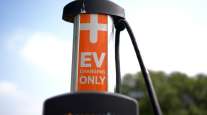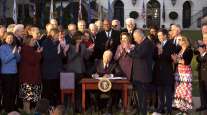Bloomberg News
Biden Envisions Thousands of Wind Turbines Spinning at Sea to Bolster Grid

[Ensure you have all the info you need in these unprecedented times. Subscribe now.]
The Biden administration is outlining ambitions to dramatically boost offshore wind power in the U.S. by 2030, pushing to drive construction of projects at sea capable of generating enough electricity for more than 10 million American homes.
Top administration officials unveiled the new goal in a March 29 meeting with state officials, executives and labor leaders, as part of President Joe Biden’s push to counter climate change, promote renewable energy and strip the electric grid of greenhouse gas emissions by 2035. As part of the push, federal regulators took steps to advance the sale of offshore wind farm rights in Atlantic waters south of New York’s Long Island.
The wind energy initiative dovetails with the administration’s work on a new U.S. carbon-cutting pledge aligned with efforts to keep average global temperatures from rising more than 1.5 degrees Celsius from pre-industrial levels.
“President Biden believes we have an enormous opportunity in front of us,” National Climate Adviser Gina McCarthy said in a March 29 statement. “Nowhere is the scale of that opportunity clearer than for offshore wind.”

Even before the pandemic, DHL's Larry S. Onge and Jim Monkmeyer set up strategies and implemented technology in order to respond to disruptions. Now, they know exactly how to get the vaccine from point A to point B — and, better, how to do it at a global scale. Hear a snippet, above, and get the full program by going to RoadSigns.TTNews.com.
The target of deploying 30 gigawatts of offshore wind power generation capacity in nine years would require developers to install thousands of turbines capable of generating hundreds of times more power than the two small existing installations in state and federal waters today.
Huge Prize
To satisfy the goal, Biden’s administration will have to navigate oft-competing interests — including those of project developers, environmentalists, organized labor and fishermen — while dedicating more Interior Department resources to vetting multibillion-dollar wind projects.
But the prize is huge — potentially luring more than $12 billion in annual capital investment and supporting 44,000 workers tasked with installing turbines along U.S. coasts, according to the White House. McCarthy cast the effort as a way to jump-start not just offshore wind development, but domestic manufacturing to supply it.
“We’re talking about massive turbines that are actually manufactured in the United States,” McCarthy said during a White House event. “We’re talking about steel and cement that’s made right here. We’re talking about these special ships that need to install these huge structures that are U.S. flagged and built in U.S. ports.”
While offshore wind has thrived in Northern Europe, where subsidies helped fuel the ventures, it has languished in the U.S. That’s in part because it’s far more expensive than other types of clean power onshore, and U.S. developers must navigate a phalanx of local and federal permitting.
“Although offshore wind is a much more mature enterprise in Europe than the U.S., I anticipate we will see much more development domestically,” Angie Gildea, U.S. energy and resources sector leader at KPMG LLP, said in an interview.
Some of the new investment may focus on the Texas coast, where there are looser regulations and lower construction costs, Gildea said.
The administration is announcing an array of moves it says will support the burgeoning industry in the U.S., including $230 million in funding for port infrastructure, $3 billion in loan guarantees to project developers and awarding some $8 million to 15 research and development projects.
The Interior Department’s Bureau of Ocean Energy Management also is taking the next steps toward selling wind development rights in the New York Bight, a shallow stretch of the Atlantic between Long Island and New Jersey. The agency is detailing a new wind energy area for potential development in the region that builds on years of analysis and sets the stage for a possible sale in late 2021 or early 2022.
RELATED: Biden Economic Plan to Focus First on Infrastructure This Week
The New York Bight could fit enough windmills to power all of New York City, but it’s also home to some of the world’s richest scallop beds — a conflict that bedeviled agency action under the Trump administration.
The bureau also is announcing plans to begin environmental analysis of Orsted A/S’ Ocean Wind project planned in waters near New Jersey. The wind farm would have a capacity of 1.1 gigawatts that could power 500,000 New Jersey homes.
Plans for 14 offshore wind farms are already pending before the bureau, which said March 29 it is seeking to complete review of at least 16 proposals representing more than 19 gigawatts of generating capacity by 2025. The agency is on track to announce its final decision on the $2.8 billion Vineyard Wind project near Massachusetts in April.
The administration’s initiative builds on a modest goal Biden announced his first week in office — to double wind generation in U.S. waters by 2030. With existing wind farms along the East Coast providing less than 100 megawatts of generation capacity today, the approval of Vineyard Wind alone would satisfy that target.
Want more news? Listen to today's daily briefing below or go here for more info:




